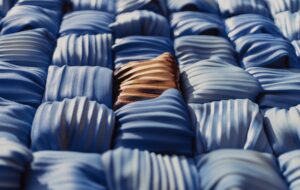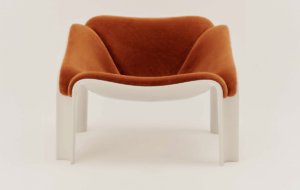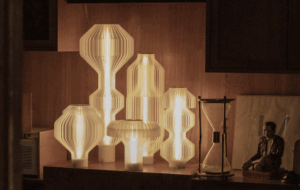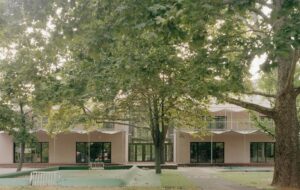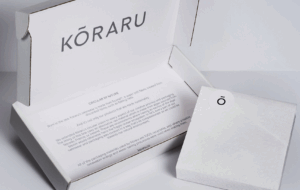


words Marcus Fairs
“I am a colour girl. I’m not a black-dressed designer. I’m not like that at all.”
Ineke Hans is wearing fleece-lined leather boots even though it’s hot, and an assembly of greens, browns and blues even though she’s best known for her collections of furniture, toys and ceramics that are entirely black. “I’m a bit schizophrenic,” she laughs.
Hans is one of the most highly regarded Dutch designers but also one of the least typical: unlike most of her generation, she didn’t study at Design Academy Eindhoven and didn’t start her career designing highly conceptual pieces for Droog. Instead, besides her critically acclaimed furniture, her CV includes four
years designing candlesticks and laundry baskets for Habitat and a couple of recent Red Dot industrial design awards for a garlic crusher and a soup bowl.
“To some people it’s totally weird that I did [the garlic crusher],” she says. “It’s the opposite of what I did before, but for me it’s like, if you design you have to solve puzzles. I can do that.”
Just to add further contradiction, the Dutch designer and I are talking at a café table in a courtyard at Swedish Home, Sweden’s collective show in Milan’s Zona Tortona during the furniture fair, and the waiting staff must think we’re earnestly discussing Scandinavian design as they are keeping us readily supplied with free food and drink.
The interview follows an amusing photo shoot on a construction site in Via Savona, next to Swarovski’s Crystal Palace show in which Hans is exhibiting a cluster of lights, and up the road from the Ahrend show, which includes a bench of hers. Hans gleefully played up to the camera like a child, balancing on heaps of rubble, leaping off coils of plastic piping and squatting in a corner as if she was doing an alfresco wee. Yes, definitely a colour girl.
Hans, 39, is also unusually honest, speaking with typically Dutch frankness about herself and her work. “I’m very moody,” she confides. “I can be very optimistic but I really have to force myself not to be too negative, because I see a lot of things around me where I really think, ‘Oh my God! Why, why, why, why do we have this?’”
She makes no pretence at slickness and uses the phrase “down to earth” repeatedly in conjunction with herself and her design approach. “I’m a real slow designer. I’m not very good at getting myself organised and talking to people and getting the right people to work for. It’s so hard for me to do that. But it’s slowly coming up now and people are phoning up with projects, which is really nice, and it’s because of the Black work, because they know I’m not a one-hit wonder.”
Hans studied at the Hogeschool voor de Kunsten in Arnhem and then at the Royal College of Art in London, where her final show caught the attention of Habitat. “Every day there was someone from Habitat at my degree show and at the end of the show the head of their design department came and said, ‘We would like you to design for us’. I said okay.”
She designed furniture and products for the retail chain, churning out dozens of ideas every week. “It was really hard work,” she recalls. “They did summer collections and winter collections. You had to come up with 60 concepts, and then we’d narrow it down to 40, and then we’d talk to the buyers and make drawings of 20 and then prototypes of 15 and in the end, every half-year, there’d be ten things in the shop. And then we’d do it again and again and again.”
Her most successful piece, she says, was a flatpack folding metal table with a handle cut out of the table top. “It sold quite well. It got copied by Ikea later on. But it never had my name on it – it was not like that at Habitat.”
Hans found the studio environment as difficult as the workload. “I couldn’t bear it because there were all these girls talking about mortgages and getting from the studio back to the suburbs as quickly as possible. So I worked from home, and every Wednesday afternoon I came in on my bicycle and went out for coffee for the whole afternoon with Gregorio Cappa [Habitat’s then co-ordinator of furniture design]. The girls in the office would be like, ‘She’s never here, then she just goes for coffee with Gregorio.’ They were all totally mad with me.”
Hans moved from London back to Arnhem in 1998 to set up her own studio where, perhaps as a reaction to her five-year grind in a commercial studio, she began to produce furniture that appeared not to have been designed at all. One of the first pieces she produced was Ordinairy – a simple square-topped table and stool constructed from planks of wood-effect recycled plastic. Ordinairy has the raw honesty of vernacular items constructed out of necessity, and Hans says she was inspired by pieces she had seen in folk museums.
“It’s really how you would imagine a table,” she says. “It’s four legs with planks. It’s very down to earth in a way but using a material which tends to put people on the wrong leg because they think it’s wood and it isn’t.”
Ordinairy, like much of her work, has the quality of a pictogram: a raw and almost unsettling distillation of what a table needs to be. If a child were to draw a table, it would look like this. “I’m interested in typologies and how people look and how people interact with images and how they always tend to make connections in their brains,” she says. “I’ve worked for a long time to make really plain, sober stuff that is really recognisable instantly, but when you have a good look at it there is more going on than you thought.”
Ordinairy was a precursor of her Black work – a series of self-initiated collections that have expanded over the years as she adds more objects (she has a tendency to create collections because, she says, she finds it difficult to choose what to keep and what to reject) and which grew into something of a treatise on the power of the colour black. Her Black Beauties collection of children’s furniture and toys, for example, seems almost sinister since such objects are stereotypically painted in bright colours; her Black Gold ceramic range is disturbing since tableware is almost always white (and doubly so since the black pigment causes the clay to warp in the kiln). She even published a book exploring the effect of the colour, called Black Bazaar, in 2003.
Yet she claims the genesis of this work was something of a joke. “When I went to buy materials for my early self-initiated work they would say, ‘Yes, madam, you can have it in colours but only black, white and neutral,’ so I thought I would just make a joke. I decided for one year to do only black things. It took on a life of its own and that’s not bad at all. But I can do other things as well.”
The award-winning garlic crusher Hans designed last year for Dutch cookware brand Royal VKB is proof of this. Dispensing with the over-complex pressing mechanisms employed by most of such implements, Hans’ design consists simply of a stainless steel roller with a serrated central section. “I hate garlic crushers,” she says. “You can’t clean them, if you put them in the dishwasher all those little holes fill up with garlic, it’s just a nightmare. So I tried to be very down to earth and make something that is very easy to clean which you can use in the kitchen and wash under the tap.”
She explains how the steel has a high copper content, meaning it removes the scent of garlic from your hands if you rub it against your skin as you wash it. “It really works!” she exclaims. “Some grandmothers used to run their hands against their knives to make the odour of fish or garlic go away.”
This was not a design she agonised over: “I found it really easy to do,” she says. “We really made it in ten minutes. We made a little mock-up with a broomstick and part of a bolt. I have a constant feeling that I’m so normal in what I do; it’s not so spectacular at all. It’s kind of obvious.”






